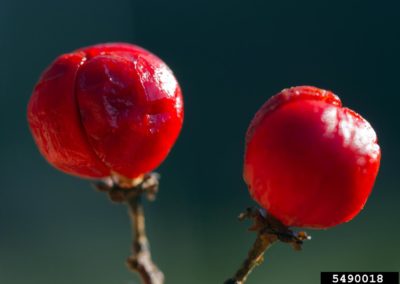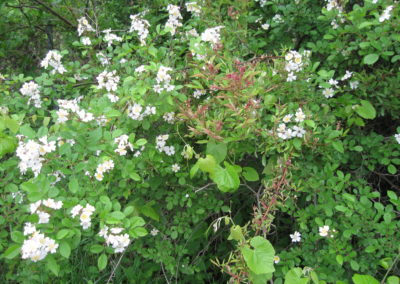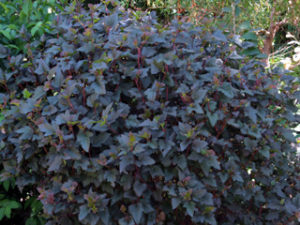Multiflora Rose (Rosa multiflora)
Invasive Management Profile
Multiflora Rose was a popular bush because of its beautiful white blooms, but it is now against Indiana State Law to plant any variety of multiflora rose without a permit issued by the division director. So you cannot buy, sell, or plant multiflora rose.
Identification
Multiflora rose is a climbing and rambling shrub with single stem, or at times multiple stems, which can grow up to 10 to 15 feet or more. The branchs are reddish green with stiff, curved thorns. The leaves are alternate and compound, composed of five to eleven leaflets. The serrate leaflets range in size from ½ inch to 2 inches long and are ovate in shape with a pointed tip. White flowers appear from May through June and are grouped or clustered. Red berries appear in August and stay on the plant throughout the winter.
Tools & Supplies Needed
- Shovel and/or spade
- Handsaw and/or lopper
- Protective eyewear, gloves, and clothing
- Paper or plastic bags for disposal
Removal Methods
For lighter and less dense infestations of Multiflora Rose, pulling is the recommended form of removal.
STEP 1 : Identify plant using our identification tips and photos as well as the time of year and growth stage.
STEP 2 : Wear protective eyewear, gloves, and clothing.
STEP 3 : Use your hand to grab the bottom of the plant, twist and pull.
STEP 4 : When pulling, make sure to remove the taproot, which is the main root system (this may be easily removed with a spade or shovel as well).
STEP 5 : Make sure to place all plant debris into a plastic or paper bag to control seed spread.
Cutting can also be an effective way of removal, although cutting and pulling may have to be repeated over several years due to regrowth from the plant.
STEP 1 : Identify plant using our identification tips and photos as well as the time of year and growth stage.
STEP 2 : Wear protective eyewear, gloves and clothing.
STEP 3 : Using a lopper cut the branches as close to the ground as possible leaving a stump.
STEP 4 : Once cut, apply undiluted herbicide to the stump. Or, if possible, dig up the root system using a sharp shovel. If you choose to use herbicide, click here for more safety information.
STEP 5 : For removal of the root system, start digging 3 feet away from the base of the stump.
STEP 6 : Once you can see the majority of the rootball, slide your shovel under it and gently begin loosening and prying it up, away from the ground.
STEP 7 : Once the rootball is free place it and all clippings on a tarp to stop the spreading of seeds or regrowth.
Disposal
Small sapling shrubs of Multiflora Rose can be disposed of in the trash and will be picked up through regular trash collection. Multiflora Rose shrubs can be picked up through the city’s heavy trash collection provided they are tied into bundles no larger than 3 feet by 3 feet, be carrels of the thorns. Heavy trash collection guidelines and monthly pick-up days for your address can be found here.
Native Alternative Species
To learn more about natives and how to landscape with them click here.
Shrubby Cinquefoil (Potentila fruticosa)
|
Growth Type: Deciduous shrub
Height: 2 to 4 feet
Spread: 3 to 5 feet
Bloom Time & Description: June to September; showy yellow flower
Fruit: Showy, Edible
Light exposure: Full sun to part shade
Attracts: Butterflies
Tolerate: Rabbit, Deer, Drought, Erosion, Clay Soil, Air Pollution
|
Photo needed |
Ninebark (Physocarpus opulifolius)
|
Growth Type: Deciduous shrub
Height: 5 to 8 feet
Spread: 4 to 6 feet
Bloom Time & Description: May to June; showy white or pink flower
Fruit: Showy
Light exposure: Full sun to part shade
Attracts: Birds, Butterflies
Tolerate: Drought, Erosion, Clay Soil, Dry Soil, Wet Soil, Shallow-Rocky Soil, Black Walnut
Find more information here.
|
Photo Courtesy of INPAWS |





